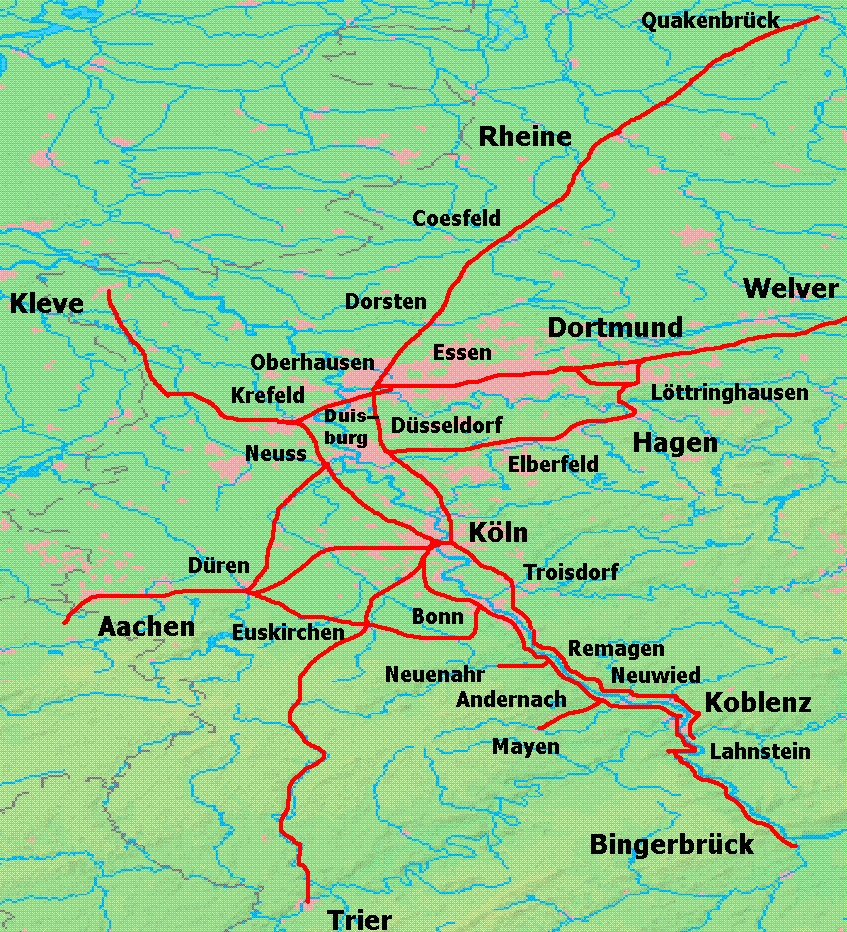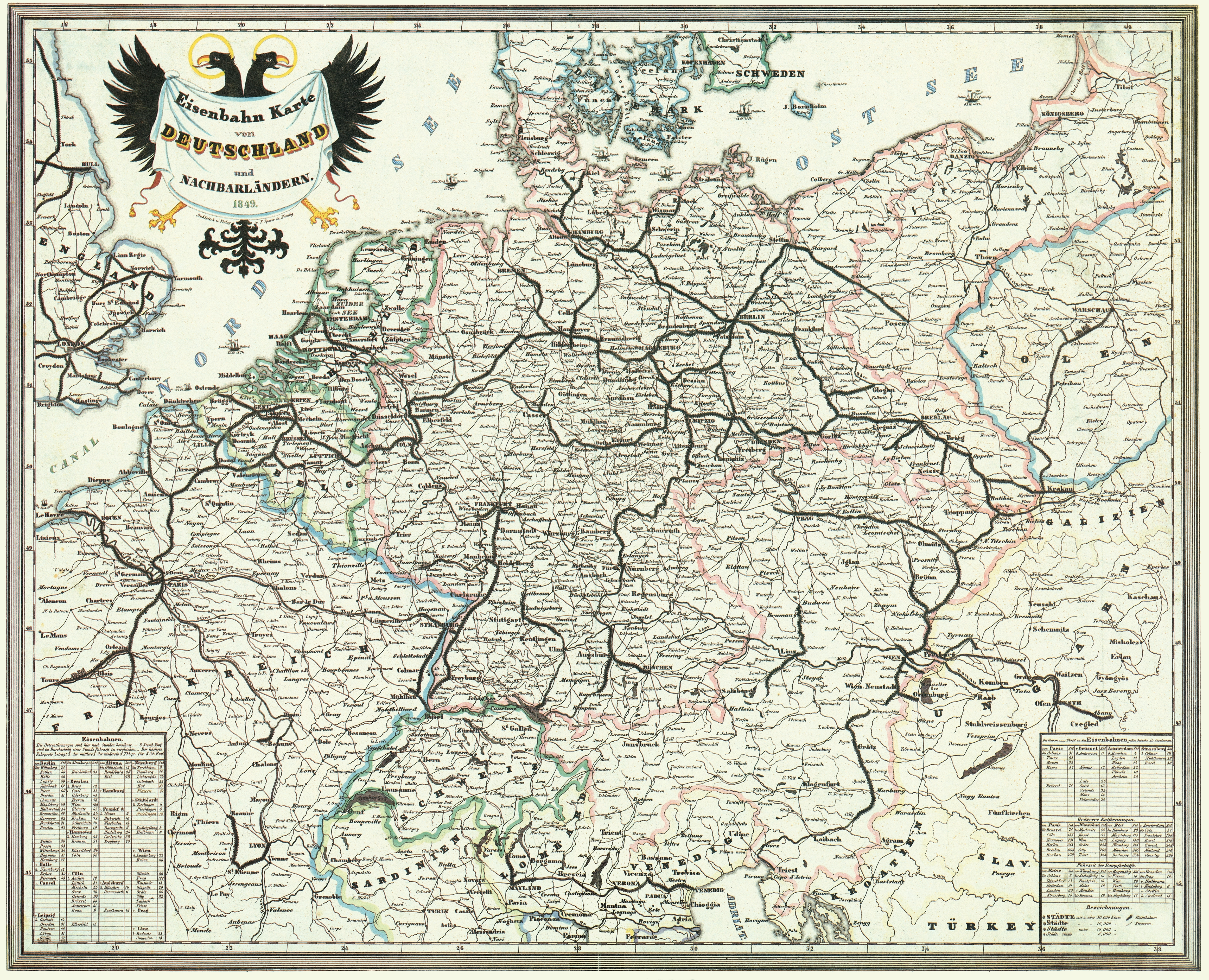|
Oberhausen–Duisburg-Ruhrort Railway
The Oberhausen–Duisburg-Ruhrort railway is a line in the German state of North Rhine-Westphalia. It runs from Oberhausen via Duisburg-Meiderich to Duisburg-Ruhrort. The line is now classified as a main line, although it is not electrified and west of Duisburg-Meiderich Sud station it is entirely single-track. History The Cologne-Minden Railway Company (''Cöln-Mindener Eisenbahn-Gesellschaft'', CME) opened the first railway in the Ruhr with the completion of its trunk line in 1847. This allowed coal mined in the Ruhr to be brought to consumers in the Lower Rhine. It entered into a contract with the Ruhrort-Crefeld District Gladbach Railway Company (''Ruhrort–Crefeld−Kreis Gladbach Eisenbahngesellschaft'', RCG) to build a line to Ruhrort and to establish a train ferry between Ruhrort and Homberg. The RCG agreed to build a line from Homberg to Mönchengladbach. The CME opened its branch line from Oberhausen Station via Meiderich to Ruhrort on 14 October 1848. Under the ... [...More Info...] [...Related Items...] OR: [Wikipedia] [Google] [Baidu] |
North Rhine-Westphalia
North Rhine-Westphalia or North-Rhine/Westphalia, commonly shortened to NRW, is a States of Germany, state () in Old states of Germany, Western Germany. With more than 18 million inhabitants, it is the List of German states by population, most populous state in Germany. Apart from the city-states (Berlin, Hamburg and Bremen), it is also the List of German states by population density, most densely populated state in Germany. Covering an area of , it is the List of German states by area, fourth-largest German state by size. North Rhine-Westphalia features 30 of the 81 German municipalities with over 100,000 inhabitants, including Cologne (over 1 million), the state capital Düsseldorf (630,000), Dortmund and Essen (about 590,000 inhabitants each) and other cities predominantly located in the Rhine-Ruhr metropolitan area, the largest urban area in Germany and the fourth-largest on the European continent. The location of the Rhine-Ruhr at the heart of the European Blue Banana make ... [...More Info...] [...Related Items...] OR: [Wikipedia] [Google] [Baidu] |
Oberhausen
Oberhausen (, ) is a city on the river Emscher in the Ruhr Area, Germany, located between Duisburg and Essen ( ). The city hosts the International Short Film Festival Oberhausen and its Gasometer Oberhausen is an anchor point of the European Route of Industrial Heritage. History Oberhausen was named for its 1847 railway station which had taken its name from the List of castles in North Rhine-Westphalia, Oberhausen Castle. The new borough was formed in 1862 following inflow of people for the local coal mines and steel mills. Awarded town rights in 1874, Oberhausen absorbed several neighbouring boroughs including Alstaden, parts of Styrum and Dümpten in 1910. Oberhausen became a city in 1901, and they incorporated the towns of Sterkrade and Osterfeld in 1929. The Hoechst AG, Ruhrchemie AG synthetic oil plant ("Oberhausen-Holten" or "Sterkrade/Holten") was a bombing target of the oil campaign of World War II, and the US forces reached the plant by 4 April 1945. In 1973, Thyssen AG ... [...More Info...] [...Related Items...] OR: [Wikipedia] [Google] [Baidu] |
Rhenish Railway Company
The Rhenish Railway Company (German language, German: ''Rheinische Eisenbahn-Gesellschaft'', RhE) was along with the Cologne-Minden Railway Company (CME) and the Bergisch-Märkische Railway Company (BME) one of the railway companies that in the mid-19th century built the first railways in the Ruhr and large parts of today's North Rhine-Westphalia. Foundation The industrialists of the Rhineland and the Bergisches Land, then part of Prussia, sought to avoid paying the high tolls for using the Rhine imposed by the Netherlands and very early in its development, saw the possibility of the new means of transport, the railway. As early as the 1830s committees were established by the cities of the Rhineland to promote proposals for building railways. Some of the members of the Cologne committee under David Hansemann (1790–1864)—a merchant and banker from Aachen—and the Aachen Committee favoured a railway line through Belgium to the seaport of Antwerp via Liege. Belgium, which had ... [...More Info...] [...Related Items...] OR: [Wikipedia] [Google] [Baidu] |
Osterath–Dortmund Süd Railway
The Osterath–Dortmund-Süd railway is a historically significant line in the German state of North Rhine-Westphalia. Parts of it are closed, much of it is now used for freight only, but several sections are still used for Regional-Express, Regionalbahn or Rhine-Ruhr S-Bahn services. The nearly 76 kilometre long line was built in three stages between 1866 and 1874 by the Rhenish Railway Company (, RhE), creating a third major east-west line through the Ruhr area. It was intended to compete effectively with the established and profitable lines of its competitors—the Duisburg–Dortmund line of the Cologne-Minden Railway Company and the Ruhr line of Bergisch-Märkische Railway Company, but it was not successful. History The Rhenish Railway concentrated for a long time left on the territories next to the Rhine, leaving the Ruhr area with its coal mines and emerging industries to be opened up by the ''Cologne-Minden'' and the ''Bergisch-Märkische'' railway companies. The Rh ... [...More Info...] [...Related Items...] OR: [Wikipedia] [Google] [Baidu] |
Duisburg-Hochfeld Rail Bridge
The Duisburg–Hochfeld railway bridge () spans the Rhine in the German city of Duisburg on the Duisburg-Ruhrort–Mönchengladbach railway, Duisburg-Ruhrort–Mönchengladbach line. The first bridge was built by the Rhenish Railway Company and put into operation at the end of 1873. It was replaced by a new bridge in 1927, which was badly damaged during the Second World War, but rebuilt and is still serves rail traffic between the Ruhr region and Aachen. History On 23 August 1866, the Rhenish Railway Company (''Rheinische Eisenbahn-Gesellschaft'', RhE) opened its Osterath–Dortmund Süd railway, line between Osterrath and Essen to connect the coal mines in the Ruhr region with its railway network, which at that time was mainly located on the west bank of the Rhine. This line included the Rheinhausen–Hochfeld train ferry. Prior to the Austro-Prussian War, the Prussian military opposed the building of fixed bridges across the Rhine for military reasons, except in fortified citie ... [...More Info...] [...Related Items...] OR: [Wikipedia] [Google] [Baidu] |
Bergisch-Märkische Railway Company
The Bergisch-Markisch Railway Company (, BME), also referred to as the Berg-Mark Railway Company or, more rarely, as the Bergisch-Markische Railway Company, was a German railway company that together with the Cologne-Minden Railway (''Cöln-Mindener Eisenbahn-Gesellschaft'', ''CME'') and the Rhenish Railway Company (''Rheinische Eisenbahn-Gesellschaft'', ''RhE'') was one of the three (nominally) private railway companies that in the mid-19th century built the first railways in the Ruhr and large parts of today's North Rhine-Westphalia. Its name refers to Bergisches Land and the County of Mark. History Foundation The Bergisch-Markisch Railway Company was founded on 18 October 1843 in Elberfeld (today a city district of Wuppertal). Since the Cologne-Minden Railway Company had decided to build its route via Duisburg rather than through the valley of the Wupper river, the Bergisch-Markisch Railway Company (, BME) determined to build its own line through the Wupper valley, to creat ... [...More Info...] [...Related Items...] OR: [Wikipedia] [Google] [Baidu] |
Ruhrort–Homberg Train Ferry
The Ruhrort–Homberg train ferry was a German train ferry on the Rhine between Ruhrort and Homberg, now districts of Duisburg. History While the Cologne-Minden Railway Company (''Cöln-Mindener Eisenbahn-Gesellschaft'', CME) was building its Cologne-Minden trunk line, trunk line between Cologne and Minden via Duisburg between 1843 and 1847, the shareholders of the Ruhrort-Crefeld District Gladbach Railway Company (''Ruhrort–Crefeld−Kreis Gladbach Eisenbahngesellschaft'', RCG) were looking for a way to bring coal from the Ruhr to industries on the western bank of the Rhine cheaply. Technology had not yet developed for building a bridge over the Rhine. In addition, prior to the Austro-Prussian War, the Prussian military opposed the building of a fixed bridge across the Rhine for military reasons, except in fortified cities such as Cologne, Mainz, Koblenz and Düsseldorf. Therefore, the RCG decided to build a train ferry between its left (western) bank terminus in Homberg and th ... [...More Info...] [...Related Items...] OR: [Wikipedia] [Google] [Baidu] |
Lower Rhine Region (Germany)
The Lower Rhine region or Niederrhein () is a region around the Lower Rhine section of the river Rhine in North Rhine-Westphalia, Germany, between approximately Oberhausen and Krefeld in the East and the Dutch border around Kleve in the West. As the region can be defined either geographically, linguistically, culturally, or by political, economic and traffic relations throughout the centuries, as well as by more recent political subdivisions, its precise borders are disputable and occasionally may be seen as extending beyond the Dutch border. A cultural bond of the German Lower Rhine region is its Low Franconian language, specifically the Kleverlandish dialect (German: , Dutch: ), which includes the Dutch dialects just across the border. In the region's southeastern portion Bergish is spoken. Other typicalities of the area include the predominantly Catholic background as well as the Rhenish Carnival tradition. The area basically covers the districts of Kleve, Wesel, Vierse ... [...More Info...] [...Related Items...] OR: [Wikipedia] [Google] [Baidu] |
Cologne-Minden Trunk Line
{{unreferenced, date=January 2014 The Cologne-Minden trunk line is a railway built by the Cologne-Minden Railway Company (''Cöln-Mindener Eisenbahn-Gesellschaft'', CME). The line is the westernmost part of the railway line from Berlin to the Rhine that was proposed by Friedrich List in his Concept for a railway network in Germany, published in 1833. In fact, Friedrich Harkort (“father of the Ruhr”) had proposed the construction of a railway line from Cologne to Minden in 1825. History On 18 December 1843, the CME was awarded the concession to build a railway line between the metropolis of Cologne, the cities of the Rhenish-Westphalian industrial area and Minden to connect with the network of the Royal Hanoverian State Railways. A route through the Bergisches Land had been dropped was due to the high cost of the engineering structures that would have been required on the advice of the Aachen merchant and banker David Hansemann (1790-1864), who was then briefly Prussian ... [...More Info...] [...Related Items...] OR: [Wikipedia] [Google] [Baidu] |
Ruhr
The Ruhr ( ; , also ''Ruhrpott'' ), also referred to as the Ruhr Area, sometimes Ruhr District, Ruhr Region, or Ruhr Valley, is a polycentric urban area in North Rhine-Westphalia, Germany. With a population density of 1,160/km2 and a population of over 5 million (2017), it is the largest urban area in Germany and the third of the European Union. It consists of several large cities bordered by the rivers Ruhr to the south, Rhine to the west, and Lippe to the north. In the southwest it borders the Bergisches Land. It is considered part of the larger Rhine-Ruhr metropolitan region of more than 10 million people, which is the third largest in Western Europe, behind only London and Paris. The Ruhr cities are, from west to east: Duisburg, Oberhausen, Bottrop, Mülheim an der Ruhr, Essen, Gelsenkirchen, Bochum, Herne, Hagen, Dortmund, Hamm and the districts of Wesel, Recklinghausen, Unna and Ennepe-Ruhr-Kreis. The most populous cities are Dortmund (with a population of app ... [...More Info...] [...Related Items...] OR: [Wikipedia] [Google] [Baidu] |






